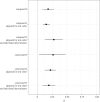The repeatability of cognitive performance: a meta-analysis
- PMID: 30104426
- PMCID: PMC6107569
- DOI: 10.1098/rstb.2017.0281
The repeatability of cognitive performance: a meta-analysis
Abstract
Behavioural and cognitive processes play important roles in mediating an individual's interactions with its environment. Yet, while there is a vast literature on repeatable individual differences in behaviour, relatively little is known about the repeatability of cognitive performance. To further our understanding of the evolution of cognition, we gathered 44 studies on individual performance of 25 species across six animal classes and used meta-analysis to assess whether cognitive performance is repeatable. We compared repeatability (R) in performance (1) on the same task presented at different times (temporal repeatability), and (2) on different tasks that measured the same putative cognitive ability (contextual repeatability). We also addressed whether R estimates were influenced by seven extrinsic factors (moderators): type of cognitive performance measurement, type of cognitive task, delay between tests, origin of the subjects, experimental context, taxonomic class and publication status. We found support for both temporal and contextual repeatability of cognitive performance, with mean R estimates ranging between 0.15 and 0.28. Repeatability estimates were mostly influenced by the type of cognitive performance measures and publication status. Our findings highlight the widespread occurrence of consistent inter-individual variation in cognition across a range of taxa which, like behaviour, may be associated with fitness outcomes.This article is part of the theme issue 'Causes and consequences of individual differences in cognitive abilities'.
Keywords: attention; cognitive repeatability; evolutionary biology of cognition; individual differences; learning; memory.
© 2018 The Author(s).
Conflict of interest statement
All authors declare there are no competing interests.
Figures



References
-
- Shettleworth SJ. 2010. Cognition, evolution, and behavior. New York, NY: Oxford University Press.
-
- van Horik JO, Clayton NS, Emery NJ. 2012. Convergent evolution of cognition in corvids, apes and other animals. New York, NY: Oxford University Press.
-
- Thornton A, Isden J, Madden JR. 2014. Toward wild psychometrics: linking individual cognitive differences to fitness. Behav. Ecol. 25, 1299–1301. (10.1093/beheco/aru095) - DOI
Publication types
MeSH terms
LinkOut - more resources
Full Text Sources
Other Literature Sources

